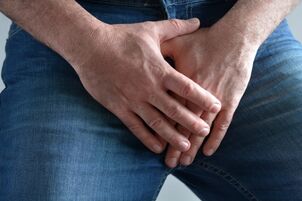
Prostatitis, like any other disease, presents with certain symptoms. It is important for a man to know exactly the first signs, because it is a signal for a visit to a doctor and further examination. We will talk about how the article manifests various forms of prostate inflammation and first aid measures.
Briefly about prostate and prostatitis
The prostate gland of an adult male is a glandular organ, consisting of two lobes and a capsule, as well as the adjacent prostate urethra. The protector performs 3 functions simultaneously:- Regulates sperm density by producing prostate juice and diluting ejaculation with it.
- Blocks the urethra at the time of orgasm.
- Participates in the production of certain hormones or controls their level in the body.
If a man's reproductive system fails, the first signs will be related to these prostate functions.
As a result of the invasion of pathogenic microflora in the prostate or after its injury, hypothermia begins, as well as stagnant processes, inflammation begins. In this case, the microcirculation of blood is disturbed, the outflow of lymph, venous blood and prostate secretions deteriorates. This leads to the development of edema and an increase in the size of the glands. As a result, the tissues are compressed, a man has a feeling of heaviness in the perineum or slight pain in the lower abdomen - the first sign of impending prostatitis.
The clinical picture will largely depend on the form of the inflammatory process and the reasons that caused it.
Symptoms of acute bacterial prostatitis
It is very difficult to miss the first symptoms of acute prostatitis - they appear suddenly and grow quickly. Often 2-4 days pass between the onset of the inflammatory process and the first sign. In this case, the clinical picture will depend on the stage of the disease.
In this case, the clinical picture will depend on the stage of the disease.
Acute bluetongue
The first sign of this type of prostatitis will be a feeling of heaviness in the perineal area, as well as increased urination at night. Body temperature does not rise in this way, because men often ignore existing problems or try to deal with them on their own, thus causing the next stage.
Acute inflammation of the follicles
At this stage, the first signs of prostatitis will be more pronounced. Many men are no longer at risk of self-medication, but go to the doctor. Complaints will be very different:
- There is a dull pain in the perineum, it may transmit to the coccyx or anus.
- Urination is painful, the person is having difficulty, which means that acute urinary retention may develop.
- Pain during bowel movement, due to which the man can not go to the toilet.
These are the first symptoms of acute follicular prostatitis, in addition to them can be added fever up to 38 degrees, general depression of the body, weakness, lethargy. A man becomes irritable, libido decreases, erectile dysfunction may occur
These symptoms persist and in the absence of appropriate treatment, the next stage develops.
Acute parenchymal inflammation
The inflammatory process has already spread to the parenchymal tissue, so it grows rapidly. The first thing a patient will notice is an increase in body temperature to high values (from 39 ° C), chills, dry mouth. The pain will become severe, deadly, can be felt both in the perineum and in the lower back, in the abdomen, in the genitals.
Urination will also change. A man will first notice an intermittent flow and then will not be able to empty his bladder at all due to severe pain. If you do not call an ambulance, there will be signs of indigestion - bloating, constipation, abdominal pain of different localization. The mucus of the fetus is expelled from the anus.
You can understand that parenchymal acute prostatitis started with its characteristic feature: the pain subsides if you lie on your back and lift your legs up. This is a clear message that medical attention is urgently needed.
The first signs of chronic prostatitis

Chronic prostatitis is a prolonged inflammation of the prostate gland, so the first signs most often begin in the acute form. However, a man from time to time expects periods of deterioration, and here you need to understand what symptoms will be accompanied. Most of the time, men complain about the following health problems:
- Burning sensation around the lash penis, especially when ejaculating or urinating
- Mild perineal pain, may radiate to pub
- Slight increase in body temperature.
With chronic prostatitis, erection problems inevitably begin, as well as the ability to participate in the conception of a child. This is due to a deterioration in prostate function, which changes the blood supply to the penis and the quality of sperm also deteriorates.
At the first signs of worsening prostatitis, you should be treated. It is not recommended to use pills prescribed by a doctor earlier without prior examination.
The clinical picture of the disease
Regardless of the form of the inflammatory process and the reasons that caused it, a man will have a noticeable triad of symptoms, with the only difference being the intensity of their manifestation. Prostatitis is always accompanied by decreased urination, pain and erectile dysfunction.Urine with prostatitis is excreted in drops or its flow is interrupted. Sometimes the jet is sprayed and then it is problematic for a man to relieve a small need while standing. The urge to urinate occurs more often at night, especially closer to morning. With stones in the prostate, urine can turn pink due to the contamination of blood.

With prostatitis, epithelial and other cells accumulate in the urethra and bacteria can also multiply. This leads to a burning sensation that intensifies at the time of urination or ejaculation.
Pain cannot be avoided. Depending on the severity of the pathological process, it may be:
- whining?
- stupid?
- download (pulsating).
Their most common location is the perineal area, just below the testicles. Radiation to the coccyx, sacrum, pubic area, penis is also possible. Anal pain may also occur, especially during pushing, because a man often has constipation.
In terms of body temperature, it rarely rises to 38 degrees. The exception is parenchymal and purulent prostatitis, in which this index can reach 40 degrees and is accompanied by chills, severe depression and sometimes confusion. In such cases, the temperature with prostatitis threatens the patient's life.
First aid for prostatitis
Treatment of prostatitis is also possible in outpatients, if we are not talking about purulent processes. But even in this case, one can not do without going to the doctor for a referral for examination and choice of regular treatment. However, the first signs of prostatitis can occur when a man can not call an ambulance, so you need to know some of the principles of first aid.

- When the temperature rises above 38 degrees, you can take an antipyretic.
- To relieve the pain, it is good to lie on your back and lift your legs as high as possible (lean against the wall or furniture).
- For particularly severe pain, you can take an anticonvulsant or insert suppositories.
As soon as possible, you should see a doctor, while at the reception you should say which medicines you have taken and in what dosage.
Traditional methods can only be used after confirmation of the diagnosis and only with the permission of the treating physician.
How prostatitis manifests itself in tests
Prostatitis refers to diseases that have no symptoms inherent only in them. For example, a burning sensation when urinating may be with urethritis and lower abdominal pain - with appendicitis or cystitis. Therefore, the final diagnosis is not made in the patient's complaints, but in the results of laboratory tests of blood, urine, semen and prostate juice. It also takes into account rectal examination data, TRUS and various other hardware methods.
The following diagnostic features are characteristic of prostatitis:
- Presence of bacteria or fungi in urine and prostatic fluid.
- The presence of leukocytes in urine and blood tests.
- Decrease in the number of leukocytes relative to the increase in the number of leukocytes during prostate secretion.
- Blood in urine or semen?
- Reduction of erythrocyte sedimentation rate in blood tests.
- Palpation pain in the prostate, change in its size and consistency.
- Change in echogenesis, granulation, contour based on TRUS results.
Combining these points with well-being complaints allows us to make an accurate diagnosis, which means that the treatment will be prescribed correctly. The quality of life of the patient, the speed of his recovery, and in some cases his life depends on it.
Conclusion
Knowing the first signs of prostatitis in men, you can navigate the changes in well-being in time and take action in advance. If perineal pain started, urine flow became infrequent and the urge to urinate became more frequent - this is a reason to suspect inflammation in the prostate and a message to see a doctor. It is better not to self-medicate in these cases.


























